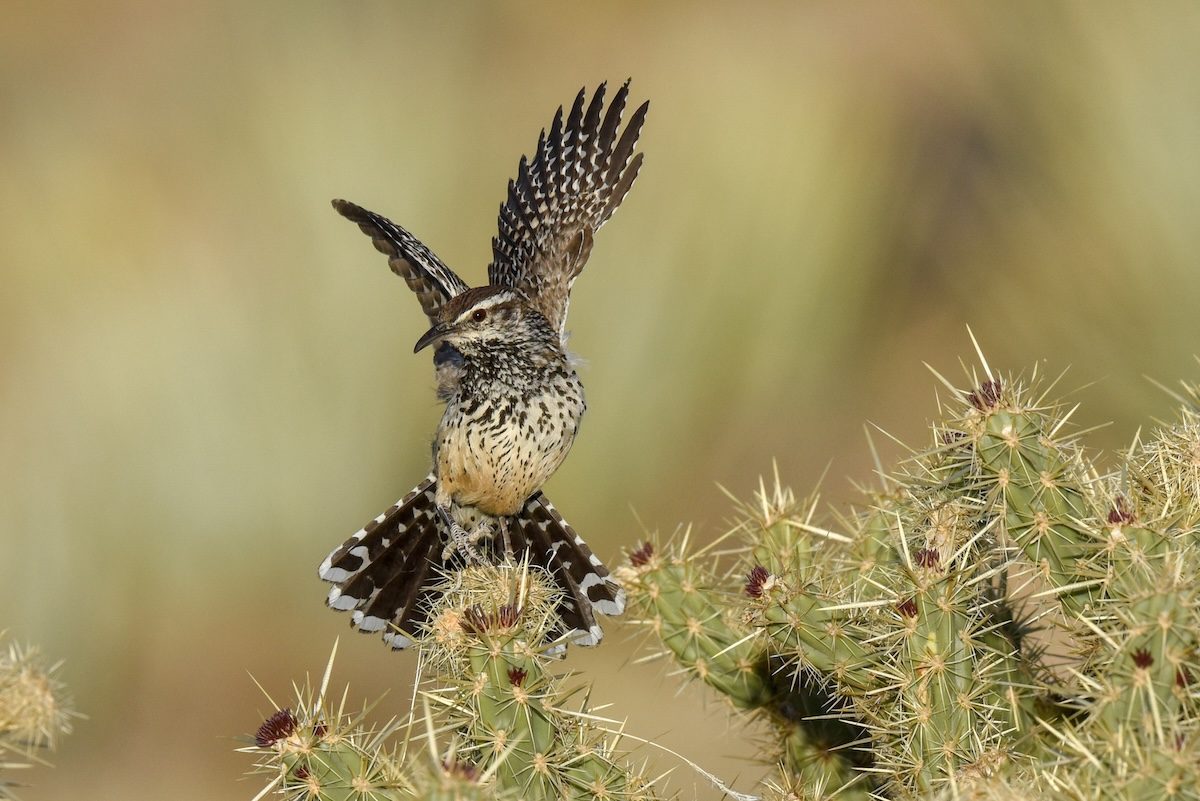Find out what a cactus wren looks like, what this desert bird eats and where to see one. Also find out where cactus wrens build their nests.

How to Identify a Cactus Wren

On This Page
What Does a Cactus Wren Look Like?

Cactus wrens are the largest type of wren found in the United States. They have boldly barred, striped and spotted plumage, and their wings and tail are barred with black. Also look for a bold white eye stripe. The cactus wren is the state bird of Arizona.
House wren vs Carolina wren: Learn how to tell the difference.
Nest and Eggs

Cactus wrens are skilled at slipping through the sharp spines of cactus thickets, choosing to build nests and raise their young there. A cactus wren nest is conspicuous—a domed affair with a tunnel entrance 5 to 6 inches (13 to 15 cm) long. The whole structure, woven of plant fibers, leaves, and twigs, is shaped somewhat like a flask lying on its side. Typically, it rests in the arms of a big cactus or on a branch of a thorny bush or mesquite tree.
According to birding experts Kenn and Kimberly Kaufman, one popular location for their bulky nests is a type of cactus called cholla, which looks like a short jumble of stout branches covered with sharp spines. The big, boldly marked birds build their nests deep within the center of this cactus. They manage to fly in and out hundreds of times without getting stuck.

They may also nest in cavities, such as a saguaro (above). A pair of cactus wrens maintain several nests at one time. They may raise three broods a year, changing nests at the beginning of each cycle.

After the young have fledged, the adults continue to make repairs to the nests, since they are also used as winter roosts.
Welcome nesting wrens to a wren bird house.
What Do Cactus Wrens Eat?

According to the Arizona-Sonora Desert Museum, cactus wrens forage for food on the ground, primarily eating insects such as ants, grasshoppers and beetles, as well as some seeds and fruit.
Enjoy more delightful pictures of wren birds.
Range and Habitat

This wren is a bird of arid, low-altitude country where cacti are plentiful. The species does not migrate. Birders will find them year-round in desert areas throughout the southwestern states, and also in dry, brushy woods.
Cactus Wren Sounds
Bird sounds courtesy of the Cornell Lab of Ornithology
The cactus wren’s loud “char-char-char” sounds ring out across the desert. You may hear this species anywhere that has enough cactus habitat to support them—even in urban areas.
Birds & Blooms reader Kim Merson says, “The noisy, busy cactus wren is my favorite bird. They always call attention to themselves with their loud look-at-me calls and tail flipping.”
Next, learn how to identify a Bewick’s wren.
About the Experts
Kenn and Kimberly Kaufman are the official bird experts for Birds & Blooms. They are the creators of the Kaufman Field Guide series and they lead birding trips all over the world.
Sources
- Arizona-Sonora Desert Museum – Cactus Wren Fact Sheet
- All About Birds – Cactus wren




















